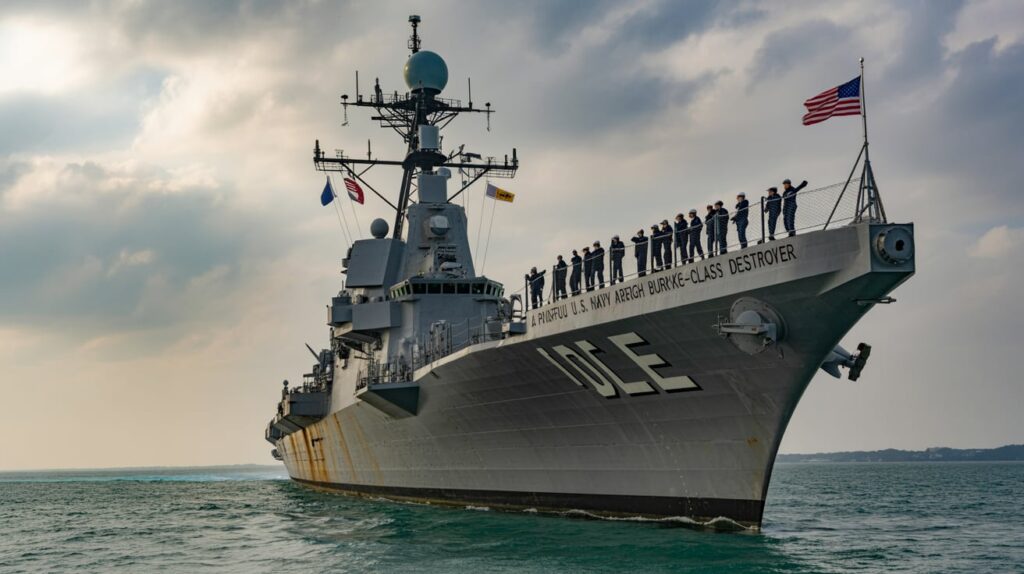The Pentagon is dispatching the USS Cole—an Arleigh Burke-class destroyer that recently served in high-stakes combat operations in the Red Sea—to bolster President Donald Trump’s ongoing border security campaign. This marks the fourth US Navy destroyer to redeploy from Middle East missions to America’s southern front, where it will support efforts to curb maritime-related criminal activity in the waters off the US-Mexico border.
On Friday, the Navy confirmed that the Cole had departed its homeport in Florida to begin its mission under US Northern Command. The destroyer joins a growing list of naval assets redirected from overseas conflict zones to domestic assignments, a move that reflects the Trump administration’s focus on militarizing border security and cracking down on illicit activity in coastal areas.

“The deployment is intended to strengthen maritime security and foster interagency cooperation,” the Navy said in a statement, emphasizing the ship’s role in presence operations and enforcement missions in collaboration with the US Coast Guard.
From the Red Sea to America’s Backyard
The Cole follows a similar path taken by three other destroyers—USS Gravely, USS Stockdale, and USS Spruance—which previously defended commercial shipping in the Red Sea from Iranian-backed Houthi drone and missile attacks. These destroyers, now operating closer to home, are part of a broader realignment of military resources to support Trump’s hardline approach to immigration and cross-border threats.
The transition from Middle Eastern combat to domestic maritime patrol may seem unusual, but the destroyers’ advanced capabilities make them versatile platforms for a wide range of missions. The Cole, for instance, is equipped with sophisticated radar and communication systems, long-endurance operational capacity, and an arsenal that includes Tomahawk cruise missiles, a five-inch naval gun, and the Phalanx close-in weapons system.

In its current mission, the destroyer will also host a US Coast Guard Law Enforcement Detachment (LEDET), a specialized unit trained for maritime interdiction operations. These teams are tasked with conducting vessel boardings, searches, and seizures as part of the campaign against illegal immigration, narcotics trafficking, and other criminal activity along the southern maritime border.
A Shifting Mission Landscape
Trump’s push to increase military involvement in border enforcement has expanded beyond ground forces and surveillance drones to now include blue-water naval assets. At least five destroyers and one littoral combat ship have been tapped for the mission, with deployments staggered to maintain continuous naval presence in the Gulf region.
The Cole is expected to join the USS Sampson, another destroyer currently deployed in the Pacific Ocean. Once the Cole enters the Gulf of Mexico—rebranded by the Trump administration as the “Gulf of America”—the two warships will anchor a maritime force focused on securing America’s coastal approaches.
Critics have questioned the practicality and cost-effectiveness of using billion-dollar warships for immigration enforcement and drug interdiction missions, but administration officials argue that the presence of heavily armed Navy vessels serves as a potent deterrent to transnational criminal networks.

Supporters within the Pentagon see the deployments as an opportunity to maintain crew readiness and interagency coordination in a real-world environment, albeit one far removed from the combat zones these ships were originally built to engage.
From Yemen to the Yucatán
For the USS Cole, this marks another significant chapter in a storied career. The ship gained national recognition in 2000 after surviving a terrorist attack in Yemen’s port of Aden that killed 17 US sailors. More recently, it served in the Red Sea, helping repel Houthi rebel assaults that threatened vital international shipping lanes.
Now, the Cole faces a new mission: patrolling the waters of the Gulf not as a defender of global commerce, but as an enforcer of domestic policy.
Its redeployment encapsulates the Trump administration’s increasingly militarized approach to border enforcement—one that blurs the lines between external defense and internal security. Whether this strategy proves effective remains to be seen, but for now, the Cole and its sister ships represent a novel fusion of foreign combat experience and domestic law enforcement.
As tensions remain high at the southern border and maritime smuggling operations grow increasingly sophisticated, the presence of destroyers like the USS Cole signals that the Trump administration is willing to apply heavy firepower to what it considers a frontline battle for national sovereignty.

Conclusion:
The deployment of the USS Cole to the US-Mexico border is a striking example of how the Trump administration is repurposing powerful military assets to serve domestic policy goals. Once engaged in defending international waters from hostile forces in the Middle East, the Cole now turns its attention to the challenges closer to home—fighting drug trafficking, illegal immigration, and transnational crime in the Gulf of Mexico. This shift highlights the administration’s commitment to using every available tool, including warships with combat pedigrees, to secure the nation’s borders. Whether this strategy proves effective or simply symbolic, it marks a significant transformation in the way America projects power—not just abroad, but within its own territorial waters.




2 thoughts on “Trump’s Pentagon Deploys Another War-Hardened Destroyer to the Southern Border—USS Cole Becomes Fourth to Shift from Red Sea to Gulf”